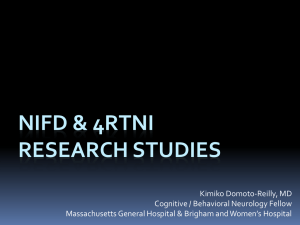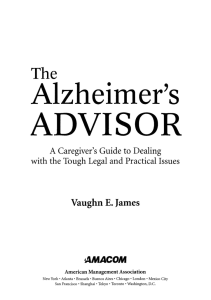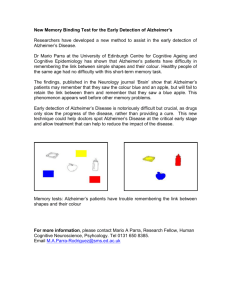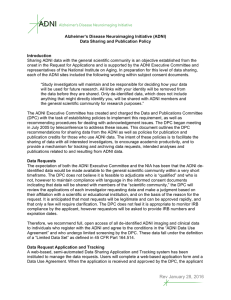Imaging Genetics of Alzheimer’s Disease: The ADNI Experience Imaging Genetics Course
advertisement
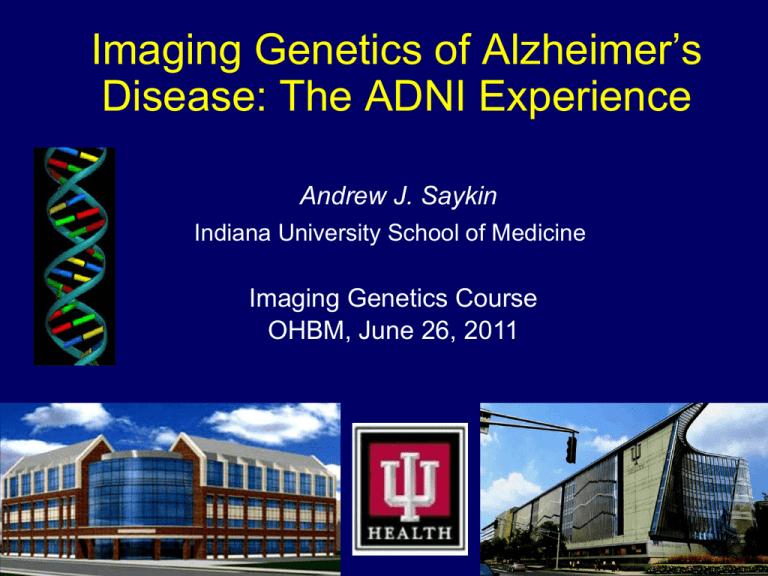
Imaging Genetics of Alzheimer’s Disease: The ADNI Experience Andrew J. Saykin Indiana University School of Medicine Imaging Genetics Course OHBM, June 26, 2011 Overview • Overview of ADNI & access to data sets • Late onset AD (LOAD) genetics – New developments in GWAS of LOAD – ADNI’s role; relevance of findings • Methodological issues in mapping between quantitative phenotypes and genetic data • Selected recent results: – Genome-wide whole brain analysis – GWAS of CSF biomarkers – Candidate gene and pathways-based analyses • Ongoing work and future plans FUNDED BY THE NATIONAL INSTITUTE ON AGING M. Weiner, P. Aisen, R Peterson, C. Jack, W. Jagust, J. Trojanowski, L. Shaw, A. Toga, L. Beckett, D. Harvey, C. Mathis, A. Gamst. R. Green. A. Saykin, S. Potkin, J. Morris, L Thal (D), Neil Buckholz, David Lee, Holly Soares Industry Scientific Advisory Board (ISAB) and Site PIs, Study Coordinators, and 821 subjects enrolled in 58 sites in US and Canada For more information & data access: http://adni.loni.ucla.edu/ Industry: Precompetitive Collaboration ADNI-1: Naturalistic Study of AD GOALS OF ADNI-1 (Funded from 10/1/2004 to 9/30/2010 NCE) • Optimize and standardize biomarkers for clinical trials • Validate biomarkers as measures of change • Validate biomarkers as diagnostics or predictors • Establish world-wide network for clinical AD studies and treatment trials • Genetics: Only APOE genotyping included for purpose of stratification; DNA & LCLs banked • For data access: http://adni.loni.ucla.edu/ NIA GRAND OPPORTUNITES (GO) ARRA GRANT (Funded From 9/30/2009 to 9/30/2011) • Adds cohort of 200 very mild “early” MCI (EMCI) • LPs on 100 of new subjects • Follow ADNI-1 controls/MCI additional yr • F18 amyloid imaging on ALL existing and new ADNI/GO subjects (AV-45) • Added Genetics Core • Complete analysis of all ADNI data SCOPE OF ADNI-2 (Funded From 10/1/2010 To 9/30/2015) • Goal to continue to follow >400 controls and MCI from ADNI-1 for 5 more years and enroll: – 100 additional EMCI (supplements 200 from GO) – 150 new controls, LMCI, and AD • • • • MRI at 3,6, months and annually F18 amyloid (AV-45)/FDG baseline and Yr 2 LP on 100% of subjects at enrollment Genetics Core World Wide ADNI C-ADNI K-ADNI J-ADNI E-ADNI NA-ADNI T-ADNI Arg-ADNI A-ADNI Future ADNI sites Courtesy of Maria Carillo of the Alzheimer’s Association Weiner et al Alzheimer’s & Dementia 6:202-211 (2010) Timeline for the Onset and Progression of Alzheimer Disease Processes Biomarkers Biomarkers are needed for early diagnosis, to predict transitions from NCI to MCI to AD and clinical trials of disease modifying therapies Shaw LM, Korecka M, Clark CM, Lee VM.-Y, Trojanowski JQ. Nat Rev Drug Discovery, 6(4):295-303, 2007. PS2 Major Genes: EOAD & LOAD APOE LOAD: genetic factors account for ~60-80% of risk (Gatz et al 2006); APOE accounts for up to 50% (Ashford & Mortimer 2002); so up to 30% remains to be found. PS1 Chromosome 19 APP 21q21.3 Chromosome 1 Chromosome 14 Chromosome 21 Genome-Wide Association Studies (GWAS) “Gene Chip” - Illumina Human 610-Quad • Non-synonymous SNPs • MHC markers • Y chromosome SNPs • Mitochondrial SNPs • 620,901 markers (~90% genomic coverage, CEU) • Single nucleotide polymorphisms (SNPs) • Copy number variation (CNVs) probes Harold et al 2009 & Lambert et al 2009 Large Case/Control GWAS in AD Gene Discoveries and AD Pathophysiology Pathways: A Beta (pink) Neurofibrillary tangles (blue) Inflammation (green) Atherosclerosis (yellow) Synaptic dysfunction (purple) Others (orange) Sleegers, Lambert, Bertram, Cruts, Amouyel & Van Broeckhoven; Trends in Genetics, 2010 Naj et al ADGC GWAS Meta-analysis (~23K: ADNI AD cases & controls included) published online 3 April 2011; doi:10.1038/ng.801 Hollingworth et al GWAS Meta-analysis (~ 26K: ADNI AD cases & controls included) published online 3 April 2011; doi:10.1038/ng.803 AlzGene Top Ten (4/18/11) http://www.alzgene.org/TopResults.asp New Candidate Genes • ABCA7: ATP-binding cassette (ABC) transporter; role in lipoprotein particle processing (APOE & CLU) • CD33: sialic-acid-binding IG-like lectins (Siglec) family; role in cell-cell interactions, regulation of immune cell function; role in endocytosis • CD2AP: CD2-associated protein. Scaffold adaptor protein associates with cortactin, a protein involved in regulation of endocytosis • EPHA1: expressed mainly in epithelial tissues; regulates cell morphology and motility; possible role in apoptosis & inflammation • MS4A family: (MS4A4, MS4A6E, MS4A6A, MS4A4E): role in immune function Putative Roles of New Candidate Genes Gene Lipid Processing Immune Function APOE X X ABCA7 X X BIN1 X X CD33 X CD2AP CLU Endocytosis X X X X CR1 X EPHA1 X MS4A family X PICALM X A. Saykin, OHBM, 2011 Imaging, Biomarkers & Clinical Endophenotypes Gene “Chip” Other QT phenotypes: clinical, cognitive, fluid biomarker data Brain-Genome Association Strategies Candidate Gene/SNP Biological Pathway Genome-wide Analysis ROI Risacher et al 2010 Sloan et al 2010 Potkin et al 2009; Saykin et al 2010 Circuit Egan et al 2001 COMT 0 Whole Brain 2 ε4 Swaminathan et al 2010 PiB ROIs & amyloid pathway Potkin et al 2009 Mol Psych schizophrenia study Reiman et al 2008 cholesterol pathway genes Shen et al 2010 ROIs; Stein et al 2010 voxels 1 AD Reiman et al PNAS 2009; Also Ho et al 2010 FTO Global Grey Matter Density of Patient Groups (AD, MCIConverter, MCI-Stable) Relative to HC Participants n=693 (148 AD, 62 MCI-C, 277 MCI-S, 206 HC) Covaried for age, gender, education, handedness and total intracranial volume (ICV) HC>AD R L L R R L R R L R HC>MCI-Converters R L L R p<0.005 (FDR), k=27 HC>MCI-Stable R L L R R L Risacher, Saykin, Shen et al; Current Alzheimer Research 2009; 6(4): 347-361 R Relationship of Global Grey Matter Density Among Patient Groups (AD, MCI-Converter, MCI-Stable) n=693 (148 AD, 62 MCI-C, 277 MCI-S, 206 HC); p<0.005 (FDR), k=27 Covaried for age, gender, education, handedness and total intracranial volume (ICV) MCI-Stable>AD R L L R R L R L R MCI-Stable>MCI-Converters R L L R R MCI-Converters>AD – No Significantly Different Voxels Risacher, Saykin, Shen et al; Current Alzheimer Research 2009; 6(4): 347-361 AD Phenotype: MTL Grey Matter Density, Volume, and Cortical Thickness in the ADNI Sample at Baseline N=693 (148 AD, 62 MCI-C, 277 MCI-S, 206 HC); p<0.005 (FDR) Risacher, Saykin, Shen et al; Current Alzheimer Research 2009; 6(4): 347-361 Regions Showing the Greatest Effect Sizes when Comparing MCI-Converter and MCI-Stable Participants at Baseline Risacher et al Curr Alzheimer Res 2009; 6(4): 347-361 Overview of ADNI Genetics Saykin et al (2010) Alzheimer’s & Dementia Publications using ADNI GWAS data (partial): Spring 2011 1. Biffi, A., et al., Genetic Variation and Neuroimaging Measures in Alzheimer Disease. Arch Neurol, 2010. 67(6): p. 677-685. 2. Cruchaga, C., et al., SNPs associated with cerebrospinal fluid phospho-tau levels influence rate of decline in Alzheimer's disease. PLoS Genet, 2010. 6(9). 3. Furney, S.J., et al., Genome wide association with MRI atrophy measures as a quantitative trait locus for Alzheimer’s disease. Molecular Psychiatry, 2010. in press. 4. Hibar, D.P., et al., Voxelwise gene-wide association study (vGeneWAS): multivariate gene-based association testing in 731 elderly subjects. NeuroImage, 2011 in press. 5. Ho, A.J., et al., A commonly carried allele of the obesity-related FTO gene is associated with reduced brain volume in the healthy elderly. Proceedings of the National Academy of Sciences, 2010. 107(18): p. 8404-8409. 6. Jun, G., et al., Meta-analysis Confirms CR1, CLU, and PICALM as Alzheimer Disease Risk Loci and Reveals Interactions With APOE Genotypes. Arch Neurol, 2010. 7. Kauwe, J., et al., Suggestive synergy between genetic variants in TF and HFE as risk factors for Alzheimer's disease. American Journal of Medical Genetics Part B: Neuropsychiatric Genetics, 2010. 153B(4): p. 955-959. 8. Kauwe, J.S.K., et al., Validating Predicted Biological Effects of Alzheimer's Disease Associated SNPs Using CSF Biomarker Levels. Journal of Alzheimer's Disease, 2010. 9. Kim, S., et al., Genome-wide association study of CSF biomarkers Abeta1-42, t-tau, and p-tau181p in the ADNI cohort. Neurology, 2011. 76(1): p. 69-79. 10. Lakatos, A., et al., Association between mitochondrial DNA variations and Alzheimer's disease in the ADNI cohort. Neurobiology of Aging, 2010. 31(8): p. 1355-1363. 11. Naj, A.C., et al., Dementia revealed: novel chromosome 6 locus for late-onset Alzheimer disease provides genetic evidence for folatepathway abnormalities. PLoS Genet, 2010. 6(9). 12. Naj, A., et al., Common variants in MS4A4/MS4A6E, CD2AP, CD33, and EPHA1 are associated with late-onset Alzheimer's disease. Nature Genetics, 2011 in press. 13. Potkin, S.G., et al., Hippocampal Atrophy as a Quantitative Trait in a Genome-Wide Association Study Identifying Novel Susceptibility Genes for Alzheimer's Disease. PLoS ONE, 2009. 4(8): p. e6501. 14. Rimol, L.M., et al., Sex-dependent association of common variants of microcephaly genes with brain structure. Proceedings of the National Academy of Sciences, 2010. 107(1): p. 384-388. 15. Saykin, A.J., et al., Alzheimer's Disease Neuroimaging Initiative biomarkers as quantitative phenotypes: Genetics core aims, progress, and plans. Alzheimer's and Dementia, 2010. 6(3): p. 265-273. 16. Shen, L., et al., Whole genome association study of brain-wide imaging phenotypes for identifying quantitative trait loci in MCI and AD: A study of the ADNI cohort. NeuroImage, 2010. 53(3): p. 1051-1063. 17. Stein, J.L., et al., Voxelwise genome-wide association study (vGWAS). NeuroImage, 2010. 53(3): p. 1160-1174. 18. Stein, J.L., et al., Genome-wide analysis reveals novel genes influencing temporal lobe structure with relevance to neurodegeneration in Alzheimer's disease. NeuroImage, 2010. 51(2): p. 542-554. 19. Swaminathan, S., et al., Genomic copy number analysis in Alzheimer's disease and MCI: An ADNI Study. International Journal of Alzheimer’s Disease, 2011 in press. 20. Xu, C., et al., Effects of BDNF Val66Met polymorphism on brain metabolism in Alzheimer's disease. Neuroreport, 2010. 21(12): p. 802-7. Initial ADNI GWAS Report Potkin et al 8/09 Translocase of Outer Mitochondrial Membrane 40 homolog (TOMM40) 523 PolyT Assay: Collaboration with Roses et al to replicate & extend Whole Brain & Genome-wide Analysis ROI-based Voxel-based Shen et al NeuroImage 53 (2010) 1051–1063 Stein et al NeuroImage 53 (2010) 1160–1174 Shen et al 2010 [Epub] ,NeuroImage GWAS of Mean Grey Matter Density: Right Hippocampus Shen et al 2010 NeuroImage NXPH1: Novel Candidate Gene for AD that codes for neurexophilin-1 protein Expressed in Brain Neuroexphilin-1’s likely role in synaptogenesis: Protein forms a very tight complex with alpha neurexins, a group of proteins that promote adhesion between dendrites and axons (EntrezGene). VBM Analysis of NXPH1 Baseline Diagnosis x SNP for rs6463843: GG > TT R L R L R R L R L R R L R L R AD MCI HC n=715 166 AD (44 TT, 78 GT, 44 GG); 346 MCI (82 TT, 170 GT, 94 GG); 203 HC (35 TT, 105 GT, 63 GG) Shen et al 2010 NeuroImage p<0.001 (unc.), k=27 Covaried for age, gender, education, handedness and baseline ICV vGWAS, ROIs and Candidate Genes (UCLA) Voxelwise GWAS: Ran genomewide association for a quarter of a million points across 700 subjects new gene discovery method; many new SNPs; power calculations for replication (Stein et al, NeuroImage, 2010a) GRIN2b, a common glutamate receptor genetic variant, is associated with greater temporal lobe atrophy and with AD; NMDAreceptor is a target for memantine therapy (Stein et al, NeuroImage, 2010b) FTO, an obesity risk gene carried by 46% of Europeans, is associated with 10-15% frontal and occipital atrophy, and with a ~1.7kg weight gain, on average (April Ho et al, PNAS, 2010) NeuroImage 51 (2010) 542–554 CSF Biomarkers: Aβ1-42 & TOMM40 N = 377 AD+MCIc: 60 AA, 62 AG, 14 GG MCI-S: 75 AA, 55 AG, 12 GG HC: 77 AA, 22 AG, 1 GG Shen Kim, Swaminathan, et al Neurology (Jan 4 2011) CSF Biomarkers: Total Tau 10 -8 3.1 x 10-8 corrected p<.01 EPC2 (rs4499362) 10 -6 Kim, Swaminathan, et al Neurology (Jan 4 2011) New finding from CSF t-tau GWAS: Enhancer of polycomb homolog 2 (EPC2) Kim, Swaminathan, et al Neurology (Jan 4 2011) Genome Wide Association Study (GWAS) on Annual Percent Change of 1.5T MRI: Initial Data • 818 ADNI Subjects – 589 cases (MCI or AD), 229 controls – 476 males, 342 females • 620901 +2 Markers – 620901 from Illumina 610 Quad array – 2 APOE SNPs • Extensive QC protocol Saykin et al 2010 Alz Dementia Annual Percent Change in Hippocampal Volume and Grey Matter Density (ADNI Cohort) Covaried for baseline age, sex, education, handedness & ICV Risacher et al Neurobiol Aging (2010) Rate of Change: Role of APOE Main effect versus Interaction Risacher et al Neurobiology of Aging (2010); 31:1401-1418 Adjusted Annual Percent Change in Hippocampal Volume APOE (Chr 19): rs429358 is the epsilon 4 allele marker TOMM40 (Chr 19): translocase of outer mitochondrial membrane 40 homolog (LD with APOE) CADH8 (Chr 16): cadherin 8, type 2; synaptic adhesion, axonal growth/guidance (no data in AD) Saykin et al Alzheimer’s & Dementia (2010); 6:265–273 Adjusted Annual Percent Change in Hippocampal Gray Matter Density MAD2L2 (Chr 1) mitotic arrest deficient-like 2 (mitotic spindle assembly) – role in cell cycling QPCT (Chr 2): possible role in pyroglutamate formation of amyloid plaque-forming peptides GRB2 (Chr 17): growth factor receptor-bound protein 2; one isoform may trigger apoptosis LOC728574 (Chr 22): similar to retinitis pigmentosa GTPase regulator isoform C Saykin et al Alzheimer’s & Dementia (2010); 6:265–273 Neurodegeneration & AD Pathophysiology Candidate Molecular Pathways for Age Related Memory Decline Inflammation Cerebrovascular, Metabolic & Endocrine Brain Structure Plasticity / Repair & Growth Factors Brain Activity Neurotransmission & Receptors Treatment Response Molecular Biology of Memory/ LTP Proposed model of allelic variation in candidate genes related to cognition, brain structure and activity in healthy aging and preclinical AD. Saykin , OHBM 2011 Sloan et al 2010 [Epub], Am J Med Genet, DOI 10.1002/ajmg.b.31078 Amyloid Pathway PET Study: [11C]PiB Swaminathan et al, ASHG, Wash DC, Nov 2010 & submitted Amyloid Gene Pathway-PiB: Preliminary Results Swaminathan et al, ASHG, Wash DC, Nov 2010 & submitted Recent Development: AV-45 (Florbetapir) Amyloid Imaging Neuropathological Validation JAMA Jan 19, 2011 Copy Number Variation (CNV) PDF: http://www.sage-hindawi.com/journals/ijad/aip/729478/ CHRFAM7A CNV Swaminathan, et al (2011) IJAD; Epub Jun 2. Potkin Group (UCI): Mitochondrial DNA Analysis ADNI Genetics: Next Steps • ADNI-GO/2 – Ongoing DNA, RNA, cell line sample collection – Planning for genotyping of new samples • ADNI-1 data analysis – Baseline and rate of change – Copy number variation – Candidate genes & pathways, GWAS approaches – Associations with PET & CSF/plasma biomarkers – Collaborative projects, replication, other cohorts • Future: – Targeted DNA and RNA resequencing – identify key regions for intensive scrutiny – Epistasis, Transcriptomics/expression, microRNA – Epigenomics (DNA methylation, etc) Timeline for the Onset and Progression of Alzheimer Disease Processes Biomarkers Biomarkers are needed for early diagnosis, to predict transitions from NCI to MCI to AD and clinical trials of disease modifying therapies Shaw LM, Korecka M, Clark CM, Lee VM.-Y, Trojanowski JQ. Nat Rev Drug Discovery, 6(4):295-303, 2007. Acknowledgements ADNI Genotyping Working Group Indiana University • Imaging Genomics Lab – – – – – – – – Andrew J. Saykin Li Shen Mark Inlow Sungeun Kim Kwangsik Nho Susan Conroy Shannon Risacher Shanker Swaminathan • TGen – Eric Reiman – David W. Craig – Matt J. Huentelman • UC Irvine: – Steven G. Potkin – Guia Guffanti – Anita Lakatos • NCRAD & Genetics – Tatiana M. Foroud – Kelley M. Faber – Nathan Pankratz • Pfizer Genetics – Bryan DeChairo – Elyse Katz • Core Consultants (ADNI-2): – – – – – Lars Bertram (Max Planck) Lindsay Farrer (BU) Robert Green (BU) Jason Moore (Dartmouth) Paul Thompson (UCLA) Support for ADNI Genetics • National Institute on Aging – ADNI U01 AG024904 & RC2 AG036535 – R01 AG19771 & P30 AG10133-18S1 – U01 AG032984, U24 AG21886, P30 AG010129, K01 AG030514 • Institute of Biomedical Imaging and Bioengineering • Foundation for the NIH – Anonymous Foundation (Challenge Grant) – Gene Network Sciences – Merck – Pfizer (DNA extraction) • Alzheimer’s Association • Indiana Economic Development Corporation (IEDC)

